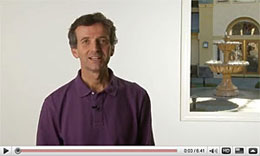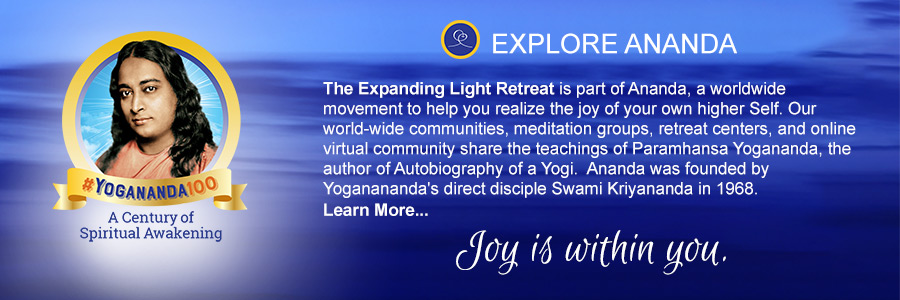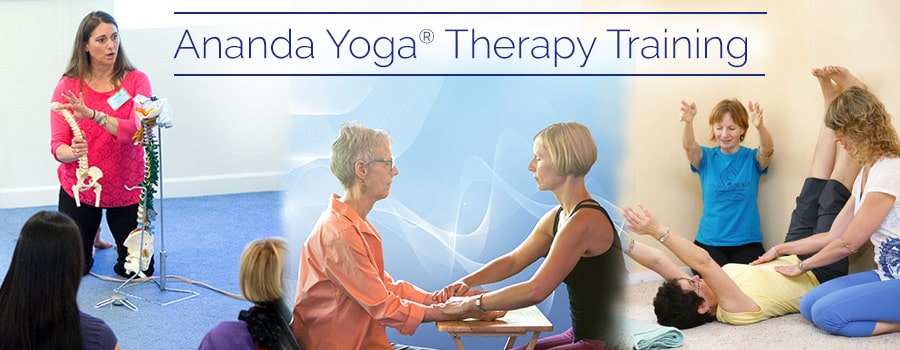SYLLABUS
Ananda Yoga® Therapy Training: Ayurveda
We are not currently accepting new students in the Ananda Yoga Therapy Training
Course Hours: Total = 36
- Residential: 26 (with 4 hours Practicum)
- Distance: 10 (as Home Practice)
- Practicum: 14 (4 Residential, 10 Distance)
Prerequisites
Enrollment in the Ananda Yoga® Therapy Training, AND,
*Ananda Yoga® Therapy Training: Principles
Teaching Format
This is a 4-day residential course which includes a combination of lecture, discussion, review sessions, case studies, and practicum (distance).
Faculty
Nayaswami Mangala Loper-Powers, RN, MN, NP, E-RYT 500, Ananda Yoga Therapist, C-IAYT, Clinical Ayurvedic Specialist, Ananda Minister
Required Texts/ Reading Materials
- Frawley, David, Yoga & Ayurveda, Lotus Press, 1999.
- Loper-Powers, Mangala, Ananda Yoga Therapy Training: Ayurveda Course Manual, 2018.
Recommended Resources
- Frawley, David, Kozak, Sandra, Yoga for Your Type, Lotus Press, 2001.
- Lad, Vasant, Ayurveda: The Science of Self-Healing, second edition, Lotus Press, 1985.
- Lad, Vasant, The Complete Book of Ayurvedic Home Remedies, Harmony Books, 1998.
- Gerson, Scott, Ayurveda: The Ancient Indian Healing Art, Element Books, Ltd., 1993.
Course Description/Progression of Course
This course builds on the Introduction to Ayurveda and Basic Ayurvedic Assessment that was part of the Yoga Therapy Training: Principles course.
(Thus, prior to this course, students have become familiar with the basic concepts of Ayurveda such as Prakruti/Consitution, Vikruti/current state of doshas, doshas and their relationships to the elements, dosha qualities, signs of doshas that are both balanced and imbalanced. They have also had some in-calss practice observing and questioning volunteers to begin to learn to see and to determine their predominant doshas. They have had the experience in their Home Practicum Assignment of observing and documenting primary dosha(s) and signs of primary dosha imbalances, and status of gunas, on their volunteer clients.)
This course begins with a review of what students learned in Principles, and an opportunity for Q & A. It covers how to bring doshas back into balance via appropriate yogic and ayurvedic therapies that are appropriate for use by yoga therapists. It outlines the Ayurvedic perspectives on stress, anxiety, depression, insomnia and immunity. Students then have an practicum with volunteers to asses their doshic responses to stress, and they give basic yoga therapy suggestions for addressing these dosha imbalances. Students also lead a session of Restorative Yoga for their volunteer clients which targets specific doshic imbalances.
The course also presents a more in-depth study of a broader range of fundamental Ayurvedic concepts, from which they are guided to understand the Ayurvedic perspecitves of health and disease (Competencies 1.3.1, #1-13), on anatomy& physiology (2.1.1-3), mental & emotional correlates with doshas (2.3.1 & 2.3.2), with the disease process (Samprapti) (1.3.2 #1 & 2), and how Ayurveda views the integration of body, mind, emotion, and spirit (2.5.1).
Students are given an overview (and review) of the Vedic Sciences and how they apply to Ayurveda and Yoga and the practice of yoga therapists. Included is presentation with emphasis on Sankhya, Vedanta, Tantra, and Yoga philosophies and how they impact the practice of yoga therapy (including topics in competency 1.1.1, a-c).
Next the course addresses a variety of medical conditions and the student learns to view them from an Ayurvedic perspective and learns some simple/basic Ayurvedic therapies that are appropriate to be include in their practice as yoga therapists. The students also learn briefly about some Ayurveda therapies which are beyond the scope of practice of a yoga therapist, but which are important for them to know about in order to make appropriate referrals to qualified Ayurvedic Practitioners. Yoga Therapy students are cautioned against thinking that this course prepares them to in any way be Ayurvedic Practitioners; nor are they qualified to determine a person’s Constitution/Prakruti. It is emphasized that the goal is for them to learn enough about Ayurveda to learn to identify probable doshic dominance (top 1 or 20 and signs of doshic imbalances, to apply simple Ayurvedic therapies in assisting clients to restore balance to their doshas (including using opposite qualities, basic Vata management). Students are also instructed in very basic Ayurvedic approaches to proper eating and proper diet for balancing doshas. Basic tenets of Ayurvedic lifestyle (vihara) are also presented.
Because of its critical role in health, per Ayurveda, the Ayurvedic view of a variety of Digestive Disorders is discussed. Students learn the importance of how lifestyle, diet and digestion are key factors in the maintenance of health or the development of disease. They learn simple Ayurvedic strategies for keeping digestion healthy, with some variations for each dosha.
Students learn how to lead yoga postures and pranayama with a focus on ‘dosha awareness’ and as a way to help keep all doshas balanced. They then demonstrate their ability to do this, as a means of teaching their clients how to apply opposite qualities in order to keep their doshas balanced.
Students have a Home Practice Assignment in which they do some basic assessment of their volunteer client’s primary dosha(s), their current guna constitution, any obvious dosha imbalances, and then they develop a yoga therapy Home Practice Plan (based on their SOAP Note) which demonstrates their ability to apply the knowledge of Ayurveda into the practice of yoga by their clients (4.1 & 4.2).
Learning Objectives
At the end of this course, students will be able to know or do the following:
- Explain briefly how the Vedic Philosophies relate to Yoga and Ayurveda and the practice of yoga therapy.
- Describe what doshas are, their elemental (both gross & subtle) components, their qualities, their signs of being balanced and imbalanced.
- Explain the meaning of Prakruti and Vikruti and how they influence the yogic and Ayurvedic therapeutic approaches to yoga therapy.
- Briefly explain how stress manifests in different doshas.
- Describe how yoga practices can be used to specifically reduce dosha imbalances in stress, anxiety, insomnia, and depression (using general Ayurvedic principles of calming/pacifying, strengthening, and purifying, as they relate to yogic practices).
- Explain why ‘Vata Management’ is an important guideline for use by yoga therapists.
- Briefly explain the Ayurvedic view of the development of the disease process (samprapti).
- Discuss why it is important to focus on digestive system function and symptoms when applying Ayurvedic principles to yoga therapy.
- Discuss the role of Ayurvedic Lifestyle and its key components as it relates to the practice of yoga therapy.
- Explain ‘healthy eating’ from an Ayurvedic perspective.
- List the basic qualities of foods that help to balance each of the 3 doshas.
- Explain why ‘time of day’ is an important consideration in Ayurveda and how it can be used in the practice of yoga therapy.
- Describe the qualities in the practice of asana, pranayama, meditation, and affirmation that will help to balance each of the 3 doshas.
Subject Matter/IAYT Competencies Covered
Section 1: Yoga Foundations
Category 1.1. Yoga Teachings & Philosophy
1.1.1 Familiarity with the evolution of the teachings and philosophy of the yoga tradition and its relevance and application to yoga therapy, including teachings from Vedic and post-Vedic periods, Samkhya,Yoga,Tantra, and Ayurveda.
a. tanmatra/bhuta/indriya (subtle element/gross elements/senses);
b. purusha/prakrti (consciousness/material world);
c. pancamaya kosha (dimensions of the human system);
e. duhkha (suffering/discomfort).
Category 1.2. Yoga and the Mind
1.2.1 Knowledge of yoga perspectives on the structure, states, functioning, and conditions of the mind, including, but not limited to,
1.2.1.1 drashtr (seer), drshya (seen);
1.2.1.2 antahkarana citta (consciousness), buddhi (intellect), ahamkara (ego), manas (mind);
1.2.1.3 citta vrtti (activities of the mind), citta parinama (structural changes in the mind), vyutthana/nirodha (mind's potential for distraction and focus)
Category 1.3. Framework for Health & Disease
1.3.1 Knowledge of the basic perspectives on health and disease from yoga and Ayurveda relevant to the practice of yoga therapy, including the concepts of
1.3.1.1 panca maya (kosha) (fundamental structure of the human system)
1.3.1.2 subtle anatomy
1.3.1.3 tri-dosha (effect of the elements on the physical body)
1.3.1.4 tri-guna (effect of sattva (equilibrium), rajas (activity), tamas [(inertia]);
1.3.1.5 prakrti/vikrti (dosha constitution at birth/imbalance of the dosha currently expressed in the body)
1.3.1.6 ama (undigested food, emotions, etc. accumulated in the body)
1.3.1.7 agni (internal fire(s) and their contribution to health)
1.3.1.8 prana vayu (prana, apana, vyana, udana,samana)
1.3.1.9 prana prakopa (disturbance of the vayu)
1.3.1.10 surya/chandra (sun/moon)
1.3.1.11 brmhana/langhana (expansion/contraction)
1.3.1.12 vyuha model: heya (the symptoms), hetu (the causes), hana (the goal), upaya (the tools)
1.3.2 Knowledge of categorizing illness, including:
1.3.2.1 Development/evolution of disease (samprapti [pathogenisis], including but not limited to direction, intensity, onset, and duration and their influence on the ease or difficulty of healing and disease management.
1.3.2.2 Setting priorities: symptoms/pacification (shamana [short term]) and purification/strengthening (shodhana [long term]).
Section 2. Biomedical & Psychological Foundations
Category 2.1. Anatomy and Physiology2.1.1 Knowledge of human anatomy and physiology, including all major systems of the body and their interrelationships, as relevant to the work of a yoga therapist.
2.1.2 Knowledge of biomechanics and movement as they relate to the practice of yoga and the work of a yoga therapist.
2.1.3 Knowledge of common pathologies and disorders of all the major systems, including symptoms, management, illness trajectories, and contraindications, as relevant to the work of a yoga therapist.
Category 2.3. Psychology and Mental Health
2.3.1 Basic knowledge of commonly occurring mental health conditions— from psychological distress to psychiatric conditions—their symptoms, and common approaches/interventions, as they relate to the work of a yoga therapist.
2.3.2 Basic knowledge of psychological concepts and terminology, including mood, cognition, behavior, and personality, as relevant to the work of a yoga therapist.
Category 2.5. Body and Mind Integration
2.5.1 Knowledge of the interaction of the body, breath, mind, intellect, and emotions in health and well-being.
Section 3. Yoga Therapy Tools and Therapeutic Skills
Category 3.1. Yoga Therapy Tools
3.1.1 In-depth knowledge of the application of yama and niyama in the context of yoga therapy.
3.1.2 In-depth knowledge of the range of yoga practices and their potential therapeutic effects for common conditions Practices may include, but are not limited to,
3.1.2.1 asana (postures);
3.1.2.2 pranayama (regulated breathing);
3.1.2.3 meditation and relaxation techniques such as bhavana (visualization), mantra (recitation),
3.1.2.4 Vihara (lifestyle modifications) including basic yogic dietary concepts.
3.1.3 In-depth knowledge of contraindications of yoga practices for specific conditions and circumstances.
Section 4. Yoga Therapy Tools and Application
Category 4.1. Yoga Practices
4.1.1 In-depth knowledge of the application of yama and niyama.
4.1.2 In-depth knowledge of the range of yoga practices and their potential therapeutic effects
4.1.2 Demonstrated ability to elicit the goals, expectations, and aspirations of the client/student.
4.1.3 Demonstrated ability to integrate information from the intake, evaluation, and observation to develop a working assessment of the client's condition, limitations, and possibilities.
4.1.4 Demonstrated ability to apply knowledge of how to determine which aspects of the client/student's conditions, goals, and aspirations might be addressed through yoga therapy.
4.1.5 Demonstrated ability to identify priorities and set both long- and short-term goals with the client/student.
4.1.6 Demonstrated ability to apply knowledge of pacification, purification, and strengthening strategies.
4.1.7 Demonstrated ability to apply knowledge of strategies that address common disorders and pathologies of the major human systems and common mental health conditions, as well as other goals and aspirations of the student as relevant to the work of a yoga therapist.
4.1.8 Demonstrated ability to apply knowledge of how to combine intake, evaluation, observations, and working assessment to develop an appropriate practice or session strategy for individual clients/students as well as group classes, taking into consideration the holistic nature of the individual.
4.1.9 Demonstrated knowledge of how to choose and prioritize the use of yoga tools and techniques, including selecting, sequencing, adapting, and modifying yoga practices appropriate to the needs of clients.
4.1.10 Demonstrated ability to teach or deliver the appropriate practices for individuals as well as groups, taking into consideration the assessment of their conditions, limitations, possibilities, and the overall practice strategy.
4.1.11 Demonstrated ability to facilitate the client/student's experience of the practice, including
4.1.11.1 Providing instruction, demonstration, education of the client/student using multimodal strategies of education such as auditory, visual, and kinesthetic learning tools;
4.1.11.2 Providing supportive strategies for the client/student to actively participate in his/her practice, such as a means to remember his/her practice (e.g., auditory and visual tools).
4.1.12 Demonstrated ability to develop and maintain therapeutic relationships including
4.1.12.1 Fostering trust by establishing an appropriate therapeutic environment through privacy, confidentiality, and safety;
4.1.12.2 Practicing effective, client/student-centered communication based upon a respect for, and sensitivity to, individual, familial, cultural, social, ethnic, and religious factors.
4.1.13 Demonstrated ability to provide follow up and re-planning, including
4.1.13.1 Gathering feedback, re-assess, and refine the practice and to determine short-term and long-term goals and priorities;
4.1.13.2 Addressing new and changing conditions, goals, aspirations, and priorities of the student/client and to provide appropriate support;
4.1.13.3 Providing appropriate closure for the therapy sessions.
Course Completion Requirements
- Attendance at all classes.
- Completion of all assigned readings. (see below)
- Participation in class discussions and activities (including case studies, review sessions, practicums). Participation needs to reflect that the student has learned and begun to assimilate the information from their assigned readings. (The faculty will be assessing whether the student has achieved the level of knowledge and appropriate application of that knowledge according to the IAYT Competencies that apply.)
- Satisfactory performance on in-class (80%) (closed-book) Quizzes. This will indicate an achievement of the stated course Learning Objectives. Students will be given Answer Keys to the Quizzes immediately after taking them, and there will then be time for further Q & A and group discussion with faculty.
- During in-class practicums, students must provide yoga therapy interventions in a safe and appropriate manner, in accordance with the IAYT Competencies for providing yoga therapy (Sections 4.1 & 4.2), as determined by supervising faculty. Students are given immediate feedback from faculty and peers on all aspects of their observational, assessment, decision-making, planning, teaching and record-keeping skills.
- Satisfactory completion of the Home Practice Assignment. (see below) Students are given written feedback by supervising faculty, along with an offer to speak in person or by phone in addition. If the expected standard of satisfactory performance (set by IAYT Standards and Competencies) is not met, then students will be given additional guidance and assignments as needed until they can demonstrate the expected competency.
- If any of the above requirements or expectations are not met, the student will be counseled and/or given additional assignments in order to help them be able to demonstrate satisfactory performance.
Ananda Yoga Therapy Training
- Overview
- Flow Chart of Ananda Yoga® Therapy Training Courses
- Course Syllabi
- Tuition Costs
- Ananda Yoga® Therapy Training Courses Scheduled
- Frequent Questions
- Instructors
- Apply for Level 1
- Student Handbook with Costs
- Bridge to Ananda Yoga
Upcoming Courses in date order
- Bhagavad Gita Retreat
- The Essence of the Yoga Sutras According to Paramhansa Yogananda
- Ananda Meditation® Teacher Training - In Person
- Advanced Pranayama
- Ananda Yoga® Assistantship
- Ananda Yoga® Therapy Training: Principles
- Ananda Yoga® Advanced Training: Therapeutic Yoga for Seniors and Bone Strength
- Restorative Ananda Yoga® Teacher Training - In Person
- Ananda Yoga® Therapy Training: Musculoskeletal–1
- Ananda Yoga® Therapy Training Online: Ayurveda
- Ananda Yoga® Therapy Training Online: Health Challenges–1
- Ananda Meditation® Solutions
- Ananda Spiritual Counseling® Training - In Person
- Ananda Yoga® Therapy Training: Musculoskeletal–2
- Ananda Yoga® Therapy Training Online: Health Challenges–2
- Ananda Yoga® Therapy Training: Psychology and Mental Health
- Ananda Yoga® Therapy Training: Holistic Health Therapist Training
Nursing CEU Eligible: details coming

How to Choose a
Yoga Teacher Training Program

“My 4 weeks of Ananda Yoga Teacher Training was one of the most fulfilling and spiritually transforming periods in my life. All of the faculty, along with the entire Ananda community, were very supportive and nurturing.” – R. F., Lake Bluff, IL.

Testimonial for the Ananda Yoga Therapy Training Program
“The program is all embracing ˜ asana, ayurveda, chakras, special health issues touching on body, mind, and spirit. The instructors were wonderful, knowledgeable, supportive, and enthusiastic.” – T.C., CA.







The yoga therapy components of these courses are based on our accreditation by IAYT, not derived from our status as an RYS with Yoga Alliance Registry.


CONNECT
14618 Tyler Foote Rd
Nevada City, California 95959
Toll free 800-346-5350
Outside US 530-478-7518
LEARN MORE
SUBSCRIBE
Receive uplifting emails with inspirational content and news about our retreat programs, travels, and trainings.
















